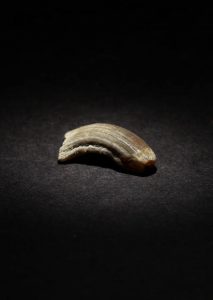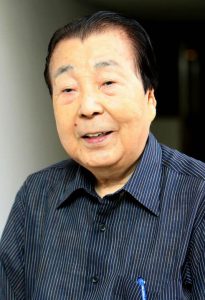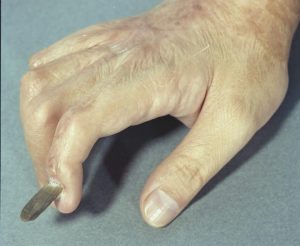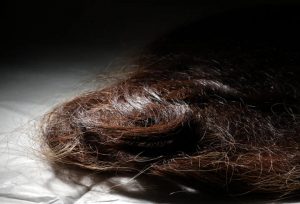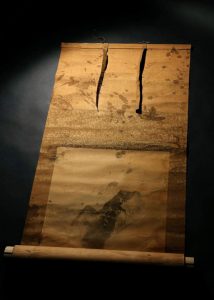Silent witness: Deformed fingernail, lost hair, blood-splattered hanging scroll
Nov. 28, 2022
by Hiromi Morita, Staff Writer
Atomic bombing-related exhibits at the Hiroshima Peace Memorial Museum, located in the city’s centrally located Naka Ward, clearly convey the horror of the blast, thermal rays, and radiation generated in the bombing. Clothing, belongings, and other articles once possessed by A-bomb survivors give visitors insight into the many lives that were taken by that single atomic bomb as well as people’s daily lives suddenly torn asunder. The museum also has on display numerous materials showing the wounds and pain inflicted on the human body by the bombing. Some of the items on display are so vivid and dreadful that visitors instinctively turn away. Nevertheless, we must not avert our gaze. Now, a time in which it has become difficult to directly conjure the tragedy 77 years ago, we should etch into our hearts and minds the reality of the consequences from the use of nuclear weapons.
Determination to convey reality of A-bombing
An arc-shaped blackish clump about 1.5 centimeters long is a fingernail that grew on the right index finger of Akihiro Takahashi, former director of the Peace Memorial Museum who died in 2011 at the age of 80 and continued to communicate the story of the Hiroshima atomic bombing as an A-bomb survivor.
Mr. Takahashi experienced the atomic bombing when he was 14 years old on the school grounds of Hiroshima Municipal Middle School (present-day Motomachi High School), located 1.4 kilometers from the hypocenter. He suffered severe burns and hovered between life and death. He ultimately survived, but was never again able to move his right elbow or the fingers on his right hand. Glass fragments had pierced the base of his index finger’s nail, from which a deformed blackish nail grew instead. The nail was too thick for him to cut himself. When the nail grew to a certain length, a crack appeared at its base. He had no choice but to wait for the nail to fall off on its own.
“The sheer horror of the atomic bombing is always at the tip of my finger. I want that fingernail to be used as a living material,” said Mr. Takahashi while still alive. He donated his index fingernail to the museum each time the fingernail fell off. The museum has archived eight fingernails, including one that was removed a half month before his death.
Mr. Takahashi was initially hesitant to show part of his body as an A-bomb related material. “Despite that, he ultimately put a priority on conveying the reality of the atomic bombing,” said his wife Fumie, 85, a resident of Hiroshima’s Nishi Ward, recalling his life.
Mr. Takahashi always said, “I will continue talking about my experience in the atomic bombing until the end of my life.” Afraid of losing his voice, even when ill in bed, he would do voice training to keep his vocal cords in good shape. He had practiced part way into his vocal training on the day before he died. He promised his wife Fumie that he would continue practicing the next day and then died.
The small clumps left behind by Mr. Takahashi are a reminder of his tenacity.
Lost hair all at once, prepared for death
Although it became faded slightly over time, the hair must have been glossy black at one time. The hair belonged to Hiroko Yamashita, who was 18 years old at the time of the atomic bombing and died in 2014 at the age of 87. She lost most of her hair on August 21, about two weeks after the atomic bombing.
Hiroko experienced the atomic bombing in the area of Hiroshima’s Otemachi, about 800 meters from the hypocenter. She was on the first floor of her house with her six-year-old, younger brother at the time, and both became trapped under the house after it had collapsed. She managed to crawl out and save her brother, with both fleeing barefoot from the city center where fires had broken out.
They were reunited with their family one week later. After that, they all stayed with relatives on the outskirts of the city. Suffering severe burns on both of her hands, shoulders, and legs, Hiroko was in such critical condition that she could barely get up from her bed. One day, when her mother, Kyo, then 46, combed Hiroko’s long, braided hair, which had not been shampooed or washed for some time, it fell out all at once.
Around the same time, a serious physical change happened to her seemingly healthy brother. His short hair fell out, and he suddenly developed a high fever. He suffered severe nosebleeds, vomited blood and, three days later, died. Hiroko, who was with him at the time of the bombing, prepared herself for death. Her family was likely feeling the same way. Her mother Kyo carefully kept the hair that Hiroko had lost at the family’s Buddhist altar as a keepsake in case she died.
Wounds caused by glass fragments left behind traces
How much blood was shed in Hiroshima that day?
A hanging scroll kept at a private house in the area of Danbara-hinode-cho (Hiroshima’s present-day Minami Ward), about 2.6 kilometers from the hypocenter, still bears a trace of splattered blood. The blood belonged to Toshiro Hiromoto, then 52, owner of the house.
It must have been a hot morning. Toshiro was at home wearing only a loincloth when the atomic bomb was dropped on Hiroshima. He was wounded by glass fragments scattered from the blast, and his blood seems to have splattered on the scroll hung in the alcove of his house. As the family Buddhist altar had protruded from the altar room, he quickly fled into the space where the altar had been located.
Toshiro had nine children. Worried, he immediately left home to search for their whereabouts. His third daughter, then 14, who was mobilized to help with work involving the demolition of buildings for the creation of firebreaks, suffered burns over her entire body and died the next day. The whereabouts of his fifth daughter, then six, who was going to a hospital in the city center, remain unknown to this day. Toshiro died in 1982 at the age of 89.
The hanging scroll was donated by his sixth daughter, Kimiko, in 2002.
(Originally published on November 28, 2022)
Atomic bombing-related exhibits at the Hiroshima Peace Memorial Museum, located in the city’s centrally located Naka Ward, clearly convey the horror of the blast, thermal rays, and radiation generated in the bombing. Clothing, belongings, and other articles once possessed by A-bomb survivors give visitors insight into the many lives that were taken by that single atomic bomb as well as people’s daily lives suddenly torn asunder. The museum also has on display numerous materials showing the wounds and pain inflicted on the human body by the bombing. Some of the items on display are so vivid and dreadful that visitors instinctively turn away. Nevertheless, we must not avert our gaze. Now, a time in which it has become difficult to directly conjure the tragedy 77 years ago, we should etch into our hearts and minds the reality of the consequences from the use of nuclear weapons.
Deformed nail
Determination to convey reality of A-bombing
An arc-shaped blackish clump about 1.5 centimeters long is a fingernail that grew on the right index finger of Akihiro Takahashi, former director of the Peace Memorial Museum who died in 2011 at the age of 80 and continued to communicate the story of the Hiroshima atomic bombing as an A-bomb survivor.
Mr. Takahashi experienced the atomic bombing when he was 14 years old on the school grounds of Hiroshima Municipal Middle School (present-day Motomachi High School), located 1.4 kilometers from the hypocenter. He suffered severe burns and hovered between life and death. He ultimately survived, but was never again able to move his right elbow or the fingers on his right hand. Glass fragments had pierced the base of his index finger’s nail, from which a deformed blackish nail grew instead. The nail was too thick for him to cut himself. When the nail grew to a certain length, a crack appeared at its base. He had no choice but to wait for the nail to fall off on its own.
“The sheer horror of the atomic bombing is always at the tip of my finger. I want that fingernail to be used as a living material,” said Mr. Takahashi while still alive. He donated his index fingernail to the museum each time the fingernail fell off. The museum has archived eight fingernails, including one that was removed a half month before his death.
Mr. Takahashi was initially hesitant to show part of his body as an A-bomb related material. “Despite that, he ultimately put a priority on conveying the reality of the atomic bombing,” said his wife Fumie, 85, a resident of Hiroshima’s Nishi Ward, recalling his life.
Mr. Takahashi always said, “I will continue talking about my experience in the atomic bombing until the end of my life.” Afraid of losing his voice, even when ill in bed, he would do voice training to keep his vocal cords in good shape. He had practiced part way into his vocal training on the day before he died. He promised his wife Fumie that he would continue practicing the next day and then died.
The small clumps left behind by Mr. Takahashi are a reminder of his tenacity.
Hair loss
Lost hair all at once, prepared for death
Although it became faded slightly over time, the hair must have been glossy black at one time. The hair belonged to Hiroko Yamashita, who was 18 years old at the time of the atomic bombing and died in 2014 at the age of 87. She lost most of her hair on August 21, about two weeks after the atomic bombing.
Hiroko experienced the atomic bombing in the area of Hiroshima’s Otemachi, about 800 meters from the hypocenter. She was on the first floor of her house with her six-year-old, younger brother at the time, and both became trapped under the house after it had collapsed. She managed to crawl out and save her brother, with both fleeing barefoot from the city center where fires had broken out.
They were reunited with their family one week later. After that, they all stayed with relatives on the outskirts of the city. Suffering severe burns on both of her hands, shoulders, and legs, Hiroko was in such critical condition that she could barely get up from her bed. One day, when her mother, Kyo, then 46, combed Hiroko’s long, braided hair, which had not been shampooed or washed for some time, it fell out all at once.
Around the same time, a serious physical change happened to her seemingly healthy brother. His short hair fell out, and he suddenly developed a high fever. He suffered severe nosebleeds, vomited blood and, three days later, died. Hiroko, who was with him at the time of the bombing, prepared herself for death. Her family was likely feeling the same way. Her mother Kyo carefully kept the hair that Hiroko had lost at the family’s Buddhist altar as a keepsake in case she died.
Blood-splattered hanging scroll
Wounds caused by glass fragments left behind traces
How much blood was shed in Hiroshima that day?
A hanging scroll kept at a private house in the area of Danbara-hinode-cho (Hiroshima’s present-day Minami Ward), about 2.6 kilometers from the hypocenter, still bears a trace of splattered blood. The blood belonged to Toshiro Hiromoto, then 52, owner of the house.
It must have been a hot morning. Toshiro was at home wearing only a loincloth when the atomic bomb was dropped on Hiroshima. He was wounded by glass fragments scattered from the blast, and his blood seems to have splattered on the scroll hung in the alcove of his house. As the family Buddhist altar had protruded from the altar room, he quickly fled into the space where the altar had been located.
Toshiro had nine children. Worried, he immediately left home to search for their whereabouts. His third daughter, then 14, who was mobilized to help with work involving the demolition of buildings for the creation of firebreaks, suffered burns over her entire body and died the next day. The whereabouts of his fifth daughter, then six, who was going to a hospital in the city center, remain unknown to this day. Toshiro died in 1982 at the age of 89.
The hanging scroll was donated by his sixth daughter, Kimiko, in 2002.
(Originally published on November 28, 2022)

